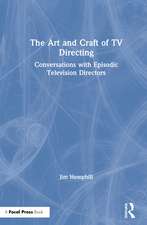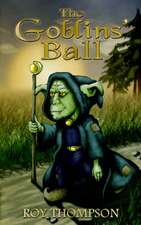Grammar of the Edit
Autor Christopher Bowenen Limba Engleză Paperback – 27 iul 2017
New to the fourth edition:
- An expanded companion website offering downloadable and editable raw footage so that students can practice the techniques described in the book, and instructional videos showcasing examples of different editing choices and types of shot transitions.
- New and expanded quiz questions and practical exercises at the end of each chapter help test readers on their knowledge using real-world scenarios.
- Updated topic discussions, explanations, illustrations and visual examples.
- An all-new chapter on Sound resources in filmmaking and Audio Editing guidelines.
| Toate formatele și edițiile | Preț | Express |
|---|---|---|
| Paperback (2) | 303.38 lei 3-5 săpt. | +20.77 lei 4-10 zile |
| Taylor & Francis – 8 aug 2023 | 303.38 lei 3-5 săpt. | +20.77 lei 4-10 zile |
| Taylor & Francis – 27 iul 2017 | 373.44 lei 6-8 săpt. | |
| Hardback (2) | 1009.43 lei 6-8 săpt. | |
| Taylor & Francis – 8 aug 2023 | 1009.43 lei 6-8 săpt. | |
| Taylor & Francis – 27 iul 2017 | 1112.49 lei 6-8 săpt. |
Preț: 373.44 lei
Nou
Puncte Express: 560
Preț estimativ în valută:
71.45€ • 74.61$ • 59.01£
71.45€ • 74.61$ • 59.01£
Carte tipărită la comandă
Livrare economică 15-29 aprilie
Preluare comenzi: 021 569.72.76
Specificații
ISBN-13: 9781138632202
ISBN-10: 1138632201
Pagini: 308
Ilustrații: 361
Dimensiuni: 152 x 229 x 25 mm
Greutate: 1.01 kg
Ediția:Revised
Editura: Taylor & Francis
Colecția Routledge
Locul publicării:Oxford, United Kingdom
ISBN-10: 1138632201
Pagini: 308
Ilustrații: 361
Dimensiuni: 152 x 229 x 25 mm
Greutate: 1.01 kg
Ediția:Revised
Editura: Taylor & Francis
Colecția Routledge
Locul publicării:Oxford, United Kingdom
Public țintă
Further/Vocational Education, Postgraduate, Professional, and UndergraduateCuprins
Acknowledgments
Introduction
Chapter One – Editing Basics
A Very Brief History of Film Editing
What Basic Factors May Affect Your Editing Choices?
The Tools
Project Type and Genre
Degree of Audience Manipulation
Other Factors
Stages of the Editing Process
The Basic Motion Picture Transitions
Chapter One Summation - Editing Purpose & Process
Related Material from Chapter Eight – Working Practices
Chapter One – Review
Chapter One – Exercises & Projects
Chapter One – Quiz Yourself
Chapter Two – Understanding the Visual Material
Basic Shot Types
Shot Descriptions
Shot Categories – The Increasing Complexity of Motion Imagery
Simple Shots
Complex Shots
Developing Shots
Chapter Two Summation – Camera Shots Are Your Building Blocks
Related Material from Chapter Eight – Working Practices
Chapter Two – Review
Chapter Two – Exercises & Projects
Chapter Two – Quiz Yourself
Chapter Three – Understanding the Audio Material
Sounds Gathered During Production
Dialogue
Room Tone / Natural Sound / Ambiance
Wild Sounds
Soundtracks (musical)
Sounds Gathered During Post-Production
Narration / Voiceover
Automated Dialogue Replacement / Looping
Ambience / Tonal Tracks
Sound Effects / Spot Effects
Foley Effects
Soundtracks (music)
Sting / Stinger
Score
Audio Terms You May Encounter
Sync Sound
Diegetic Sound
Non-diegetic Sound
Sound Design
Sound Motif
Chapter Three Summation – Sound as Emotional and Physiological Manipulation
Related Material from Chapter Eight – Working Practices
Chapter Three – Review
Chapter Three – Exercises & Projects
Chapter Three – Quiz Yourself
Chapter Four – Assessing the Footage: Selecting the Best Shots for the Job
Criteria for Shot Assessment
Focus
Framing and Composition
Exposure and Color Balance
Screen Direction
180 Degree Rule / Axis of Action
30 Degree Rule
Matching Angles
Matching Eye-line
Continuity of Action
Performance
Continuity of Dialogue / Spoken Words
Audio Quality
Be Familiar with All of the Footage
Chapter Four Summation - So How Does All of This Help You?
Related Material from Chapter Eight – Working Practices
Chapter Four – Review
Chapter Four – Exercises & Projects
Chapter Four – Quiz Yourself
Chapter Five – When to Cut and Why
What Factors Lead to Making an Edit?
Information
Motivation
Shot Composition
Camera Angle
Continuity Sound
Chapter Five Summation - Is There a Right or Wrong Reason for a Cut?
Related Material from Chapter Eight – Working Practices
Chapter Five – Review
Chapter Five – Exercises & Projects
Chapter Five – Quiz Yourself
Chapter Six – Transitions and Edit Categories
The Cut
The Dissolve
The Wipe
The Fade
The Five Major Categories of Edit Types
The Action Edit
The Screen Position Edit
The Form Edit
The Concept Edit
The Combined Edit
Chapter Six Summation - Does Everything Always Apply?
Related Material from Chapter Eight – Working Practices
Chapter Six – Review
Chapter Six – Exercises & Projects
Chapter Six – Quiz Yourself
Chapter Seven – Editing Terms, Topics, and Techniques
Additional Editing Terms
Timecode
Montage
Parallel Editing
Multi-camera Editing
Composite Editing
Rendering
Chromakey
Video Resolution
Additional Editing Topics
Sound Editing
Color Correction / Color Grading
Importing Still Images
Digital Workflow
Technology vs. Creativity
Chapter Seven Summation – Old Techniques Done With New Technologies
Related Material from Chapter Eight – Working Practices
Chapter Seven – Review
Chapter Seven – Exercises & Projects
Chapter Seven – Quiz Yourself
Chapter Eight – Working Practices
Chapter Eight – Review
Chapter Eight – Exercises & Projects
Chapter Eight – Quiz Yourself
Chapter Nine – Key Take-Aways for New Editors
Sound and Vision are Partners
A New Shot Should Contain New Information
There Should Be a Reason for Every Edit
Pacing Has a Purpose
Observe the Action Line
Select the Appropriate Form of Edit
The Better the Edit, the Less it is Noticed
Editing is Manipulation
The Role of an Assistant Editor
Editing is Creating
Chapter Nine Summation – Concluding Thoughts
Chapter Nine – Review
Chapter Nine – Exercises & Projects
Chapter Nine – Quiz Yourself
Appendix A – Helpful Resources for the New Filmmaker
Appendix B – Common Crew Members Needed for Motion Picture Production
Appendix C – Practice Script
Glossary
Index
Introduction
Chapter One – Editing Basics
A Very Brief History of Film Editing
What Basic Factors May Affect Your Editing Choices?
The Tools
Project Type and Genre
Degree of Audience Manipulation
Other Factors
Stages of the Editing Process
The Basic Motion Picture Transitions
Chapter One Summation - Editing Purpose & Process
Related Material from Chapter Eight – Working Practices
Chapter One – Review
Chapter One – Exercises & Projects
Chapter One – Quiz Yourself
Chapter Two – Understanding the Visual Material
Basic Shot Types
Shot Descriptions
Shot Categories – The Increasing Complexity of Motion Imagery
Simple Shots
Complex Shots
Developing Shots
Chapter Two Summation – Camera Shots Are Your Building Blocks
Related Material from Chapter Eight – Working Practices
Chapter Two – Review
Chapter Two – Exercises & Projects
Chapter Two – Quiz Yourself
Chapter Three – Understanding the Audio Material
Sounds Gathered During Production
Dialogue
Room Tone / Natural Sound / Ambiance
Wild Sounds
Soundtracks (musical)
Sounds Gathered During Post-Production
Narration / Voiceover
Automated Dialogue Replacement / Looping
Ambience / Tonal Tracks
Sound Effects / Spot Effects
Foley Effects
Soundtracks (music)
Sting / Stinger
Score
Audio Terms You May Encounter
Sync Sound
Diegetic Sound
Non-diegetic Sound
Sound Design
Sound Motif
Chapter Three Summation – Sound as Emotional and Physiological Manipulation
Related Material from Chapter Eight – Working Practices
Chapter Three – Review
Chapter Three – Exercises & Projects
Chapter Three – Quiz Yourself
Chapter Four – Assessing the Footage: Selecting the Best Shots for the Job
Criteria for Shot Assessment
Focus
Framing and Composition
Exposure and Color Balance
Screen Direction
180 Degree Rule / Axis of Action
30 Degree Rule
Matching Angles
Matching Eye-line
Continuity of Action
Performance
Continuity of Dialogue / Spoken Words
Audio Quality
Be Familiar with All of the Footage
Chapter Four Summation - So How Does All of This Help You?
Related Material from Chapter Eight – Working Practices
Chapter Four – Review
Chapter Four – Exercises & Projects
Chapter Four – Quiz Yourself
Chapter Five – When to Cut and Why
What Factors Lead to Making an Edit?
Information
Motivation
Shot Composition
Camera Angle
Continuity Sound
Chapter Five Summation - Is There a Right or Wrong Reason for a Cut?
Related Material from Chapter Eight – Working Practices
Chapter Five – Review
Chapter Five – Exercises & Projects
Chapter Five – Quiz Yourself
Chapter Six – Transitions and Edit Categories
The Cut
The Dissolve
The Wipe
The Fade
The Five Major Categories of Edit Types
The Action Edit
The Screen Position Edit
The Form Edit
The Concept Edit
The Combined Edit
Chapter Six Summation - Does Everything Always Apply?
Related Material from Chapter Eight – Working Practices
Chapter Six – Review
Chapter Six – Exercises & Projects
Chapter Six – Quiz Yourself
Chapter Seven – Editing Terms, Topics, and Techniques
Additional Editing Terms
Timecode
Montage
Parallel Editing
Multi-camera Editing
Composite Editing
Rendering
Chromakey
Video Resolution
Additional Editing Topics
Sound Editing
Color Correction / Color Grading
Importing Still Images
Digital Workflow
Technology vs. Creativity
Chapter Seven Summation – Old Techniques Done With New Technologies
Related Material from Chapter Eight – Working Practices
Chapter Seven – Review
Chapter Seven – Exercises & Projects
Chapter Seven – Quiz Yourself
Chapter Eight – Working Practices
Chapter Eight – Review
Chapter Eight – Exercises & Projects
Chapter Eight – Quiz Yourself
Chapter Nine – Key Take-Aways for New Editors
Sound and Vision are Partners
A New Shot Should Contain New Information
There Should Be a Reason for Every Edit
Pacing Has a Purpose
Observe the Action Line
Select the Appropriate Form of Edit
The Better the Edit, the Less it is Noticed
Editing is Manipulation
The Role of an Assistant Editor
Editing is Creating
Chapter Nine Summation – Concluding Thoughts
Chapter Nine – Review
Chapter Nine – Exercises & Projects
Chapter Nine – Quiz Yourself
Appendix A – Helpful Resources for the New Filmmaker
Appendix B – Common Crew Members Needed for Motion Picture Production
Appendix C – Practice Script
Glossary
Index
Notă biografică
Christopher J. Bowen has worked within the motion media industries for over 18 years as a cinematographer, editor, director, and educator. Currently, he is an Associate Professor of film production and visual media writing at Framingham State University. Professor Bowen is also an Avid Certified Instructor, Creative Director of his own media production company, Fellsway Creatives, and author of the companion text, Grammar of the Shot.
Descriere
Tell more effective visual stories by learning the "grammar" of cinematic language with this elegant, accessible reference. The fourth edition of Grammar of the Edit gives you the answers to the all-important questions of when to cut and why, and teaches readers the principles behind transitions, editing for continuity, selecting the best shots, editing sound, color correction, and more. Designed as an easy-to-use guide, Grammar of the Edit presents each topic succinctly with clear photographs and diagrams illustrating key concepts, practical exercises and quiz questions, and is a staple of any filmmaker’s library.
New to the fourth edition:
New to the fourth edition:
- An expanded companion website offering downloadable and editable raw footage so that students can practice the techniques described in the book, and instructional videos showcasing examples of different editing choices and types of shot transitions.
- New and expanded quiz questions and practical exercises at the end of each chapter help test readers on their knowledge using real-world scenarios.
- Updated topic discussions, explanations, illustrations and visual examples.
- An all-new chapter on Sound resources in filmmaking and Audio Editing guidelines.
Recenzii
"This is an essential book for film and media production students – especially those who want to make a career out of video editing. The storytelling function of editing is clearly explained as well as the grammar of its various forms and styles." - Dr. Matthew Kerry, Nottingham Trent University















